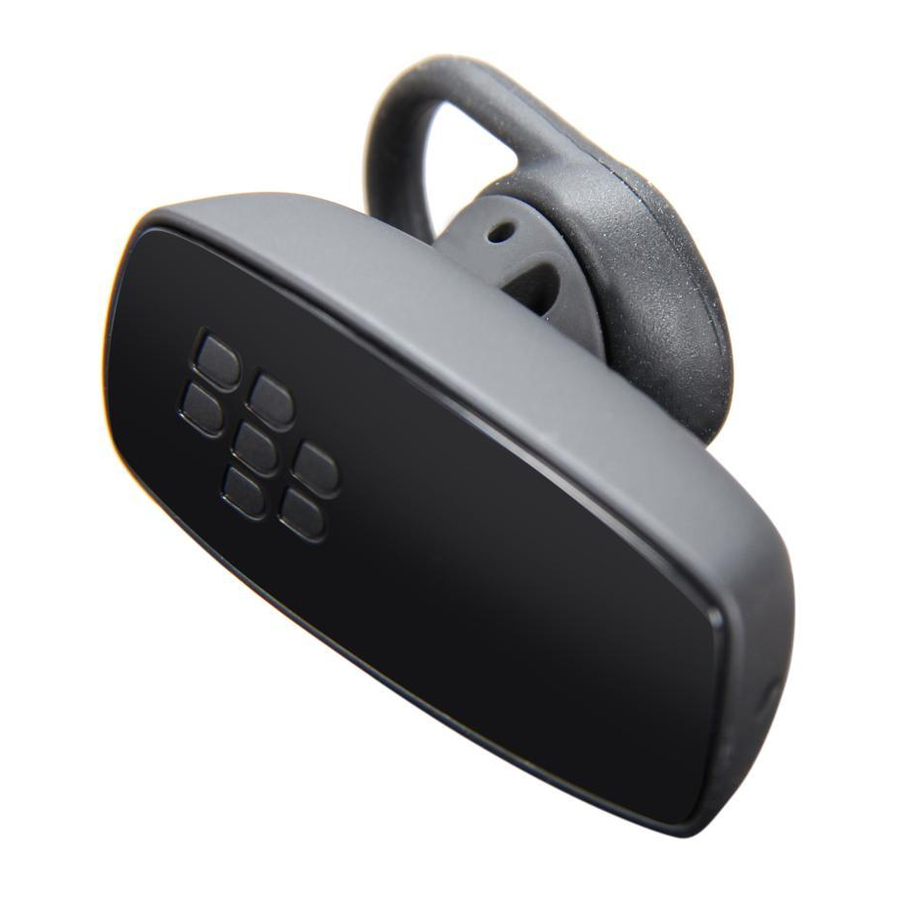Blackberry HS-300 Информация о продукте - Страница 8
Просмотреть онлайн или скачать pdf Информация о продукте для Гарнитуры Blackberry HS-300. Blackberry HS-300 15 страниц. Blackberry wireless headset hs-300
Также для Blackberry HS-300: Руководство пользователя (4 страниц), Руководство пользователя (4 страниц)

Safety and Product Information
•
Always keep the headset more than 7.88 in. (20 cm) from the pacemaker when the headset is turned on.
•
Do not carry the headset in your breast pocket.
•
If you have any reason to suspect that interference is taking place, turn off the headset immediately.
Hearing aids: Some digital wireless devices may interfere with some hearing aids. In the event of such interference, consult your wireless
service provider or contact the manufacturer of your hearing aid to discuss alternatives.
Other medical devices: If you use any other personal medical device, consult the manufacturer of your device to determine if the device is
adequately shielded from external RF energy. Your physician may be able to assist you in obtaining this information.
Health care facilities: Turn off Bluetooth® technology on the headset in health care facilities when any regulations posted in these areas
instruct you to do so. Hospitals or health care facilities may be using equipment that could be sensitive to external RF energy.
Aircraft: Federal Aviation Administration (FAA) and Federal Communications Commission (FCC) regulations prohibit using the radio of wireless
devices while in the air. Turn off the headset before boarding an aircraft. The effect of using Bluetooth technology on the headset in an aircraft
is unknown. Such use might affect aircraft instrumentation, communication, and performance, might disrupt the network, might otherwise be
dangerous to the operation of the aircraft, and might be illegal.
Dangerous areas
The BlackBerry® Wireless Headset is not an intrinsically safe device and is not suitable for use in hazardous environments, where such devices
are required, including without limitation, in presence of gas fumes, explosive dust situations, operation of nuclear facilities, aircraft navigation
or communication services, air traffic control, and life support or weapons systems.
Potentially explosive atmospheres: Turn off the headset when in any area with a potentially explosive atmosphere, and obey all signs and
instructions. Sparks in such areas could cause an explosion or fire resulting in bodily injury or even death.
Areas with a potentially explosive atmosphere are often, but not always, clearly marked. They include fueling areas such as gasoline or petrol
stations; below deck on boats; fuel or chemical transfer or storage facilities; vehicles using liquefied petroleum gas (such as propane or butane);
areas where the air contains chemicals or particles, such as grain, dust, or metal powders; and any other area where you would normally be
advised to turn off your vehicle engine.
Blasting areas: To avoid interfering with blasting operations, turn off Bluetooth® technology on the headset when in a "blasting area" or in
areas that post "Turn off two-way radio". Obey all signs and instructions.
US Information Concerning the Federal Communications Commission ("FCC")
Requirements for Hearing Aid Compatibility with Wireless Devices
When wireless devices are used near hearing devices (such as hearing aids and cochlear implants), users may detect a buzzing, humming, or
whining noise. Some hearing devices are more immune than others to this interference, and wireless devices also vary in the amount of
interference that they generate.
The wireless telephone industry has developed ratings to assist hearing device users in finding wireless devices that may be compatible with
their hearing devices. Not all wireless devices have been rated. Wireless devices that are rated will have the rating displayed on the box together
with other relevant approval markings.
The ratings are not guarantees. Results will vary depending on the user's hearing device and hearing loss. If your hearing device is vulnerable
to interference, you may not be able to use a rated wireless device successfully.
6
Safety and product information
